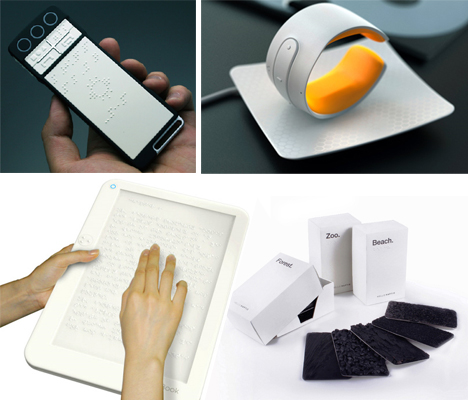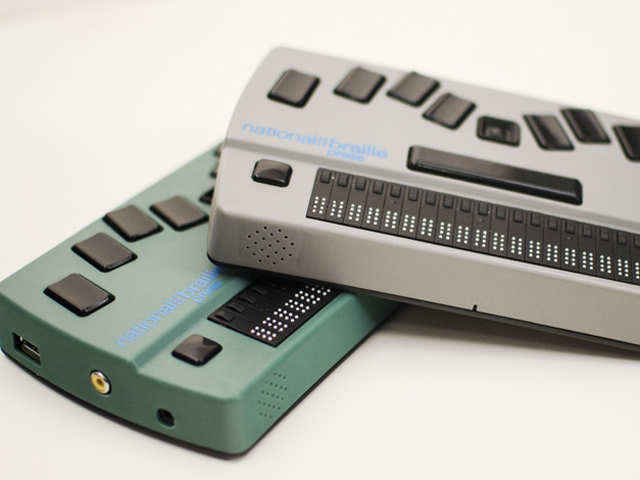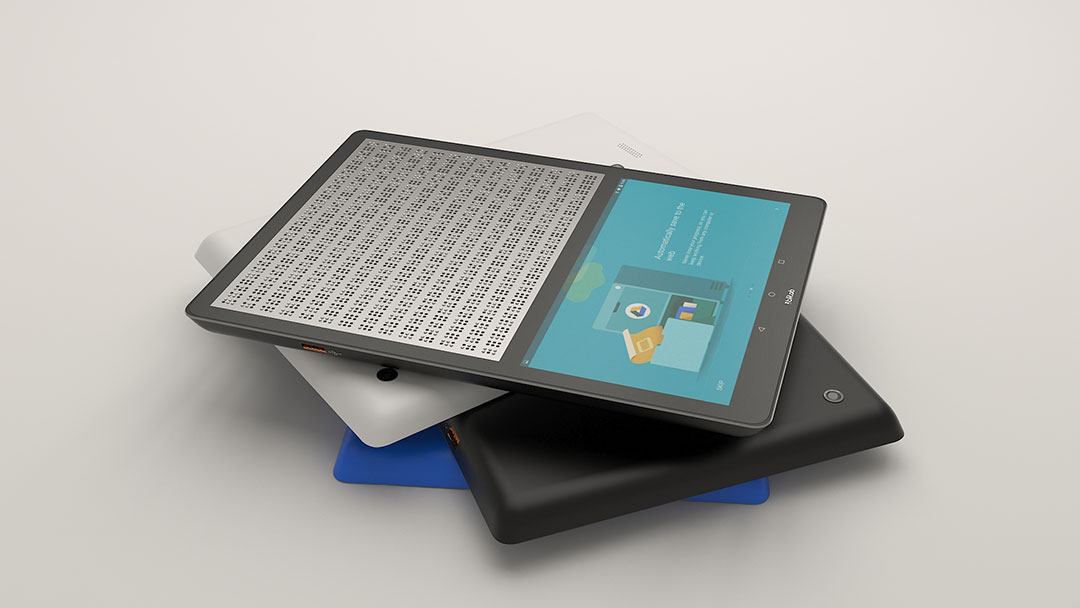Enhance Accessibility with Braille Displays and Notetakers
Enhance Accessibility with Braille Displays and Notetakers
Blog Article
Discover Ingenious Tools Made for the Aesthetically Impaired
The growth of ingenious devices for the aesthetically impaired stands for a considerable development in access and self-reliance. Technologies such as smart glasses with AI capabilities and mobile applications made to offer acoustic summaries are improving daily experiences for individuals. In addition, wearable tools that utilize haptic responses boost environmental recognition, while modern Braille technologies supply brand-new means to engage with text. As these devices continue to progress, their effect on the lives of those with visual problems elevates vital concerns concerning the future of inclusivity and freedom in various aspects of life. What lies ahead in this technical landscape?
Smart Glasses for Navigation

Smart glasses designed for navigation are reinventing the means aesthetically damaged people engage with their setting. These innovative devices utilize a combination of camera modern technology, synthetic knowledge, and acoustic feedback to offer real-time info concerning environments. By utilizing obstacle discovery systems, clever glasses can notify customers to potential threats, making it possible for much safer wheelchair in both unfamiliar and familiar setups.
The assimilation of GPS technology further improves navigation abilities, allowing individuals to receive auditory instructions as they move. This hands-free approach not just fosters independence yet additionally empowers visually damaged individuals to navigate metropolitan landscapes with enhanced self-confidence. Furthermore, several smart glasses are outfitted with attributes that determine landmarks and road indicators, offering contextual details that boosts the customer experience.
In addition, the development of these devices is continuously advancing, with business working to enhance the accuracy of item recognition and broaden the series of navigational attributes. As smart glasses come to be extra accessible and budget friendly, they hold the potential to substantially transform daily life for visually impaired individuals. Ultimately, these ingenious devices stand for a crucial step toward inclusivity, offering boosted mobility and a higher feeling of autonomy for people navigating the world around them.

Mobile Apps for Daily Living
Just how can mobile applications enhance the everyday lives of visually damaged individuals? Mobile apps are revolutionizing the way aesthetically impaired customers browse their environments, handle day-to-day tasks, and gain access to info. These applications give crucial assistance through different performances, fostering freedom and boosting lifestyle.
A number of cutting-edge mobile apps are designed particularly for daily living. For instance, applications like Be My Eyes connect aesthetically damaged users with sighted volunteers through video clip telephone calls, enabling them to receive real-time help with jobs such as reading labels or browsing unknown spaces. Similarly, Seeing AI, created by Microsoft, utilizes artificial knowledge to define environments, read message, and recognize things, successfully transforming a smartphone into an effective tool for everyday help.
Additionally, navigating apps customized for the visually damaged, such as Aira and BlindSquare, offer audio-based directions and ecological info, enabling customers to traverse their surroundings securely and confidently. Past navigating and immediate assistance, mobile applications also support company and job management, with features that assist customers establish suggestions, produce order of business, and track appointments. In summary, mobile applications work as essential sources, encouraging aesthetically impaired people to lead even more independent and fulfilling lives.
Wearable Technologies for Aid
Empowerment through innovation is progressively obvious in the realm of wearable devices made to assist aesthetically damaged people. These innovative devices integrate seamlessly right into every day life, boosting navigating and learn the facts here now providing necessary comments to users. As an example, wise glasses furnished with cams can recognize faces and review text out loud, permitting customers to connect more with confidence in social and professional settings.
Another remarkable improvement is the usage of haptic responses systems in wearable tools. These systems utilize resonances or various other tactile signals to convey details concerning the individual's atmosphere, such as obstacles or modifications in terrain, improving flexibility and safety and security. Wearable technologies also include wristbands that connect to smartphones, informing customers to notifications through refined vibrations, hence boosting connection without dependence on aesthetic hints.
As these modern technologies remain to advance, they are not just enhancing self-reliance for visually damaged people yet also cultivating a greater sense of incorporation in society. By bridging the space in between challenges faced in daily living and the potential for freedom, wearable innovations work as pivotal tools in the mission for equality and empowerment for those with visual impairments.
Sound Description Tools
Sound description devices play a crucial function in improving accessibility for visually damaged people, supplying them with the ability to engage with aesthetic media. Screen readers for the blind. These devices supply narrated descriptions of key visual aspects in movies, television programs, and live performances, making certain that users can completely comprehend the context and emotions conveyed via visuals
Audio summary can be incorporated into various platforms, consisting of streaming services, cinema screenings, and live theater. Several popular streaming solutions currently include audio description as an accessibility attribute, enabling visitors to choose it quickly. In enhancement to conventional media, specialized applications additionally exist, supplying audio summaries for art exhibits, museums, and other cultural events.
The efficiency of audio summary depends upon the skill of the storytellers, who have to share aesthetic information succinctly without diminishing the original sound. Technologies in this area are also leading the way for even great site more customized experiences, where users can adjust the level of detail and pacing according to their preferences.
Braille Innovations and Gadgets
Braille innovations and devices have actually dramatically transformed the means aesthetically damaged individuals communicate with text and details. Modern improvements have led to the glasses with magnetic frames growth of functional devices that enhance literacy and freedom amongst individuals. Significantly, Braille show innovations have developed, allowing for dynamic analysis experiences. These devices convert electronic message into Braille, enabling individuals to access a large array of info on mobile phones, computers, and tablet computers.
Furthermore, mobile Braille notetakers incorporate typical Braille input with modern performances, assisting in note-taking, scheduling, and record editing and enhancing on the move. Assistive technology for the blind. These portable devices usually feature text-to-speech abilities, bridging the gap between Braille and acoustic info
Additionally, ingenious Braille printers have arised, enabling users to produce Braille tags, documents, and academic products successfully. This accessibility fosters better involvement in expert and educational settings, eventually advertising inclusivity.
Furthermore, study into wise Braille technologies remains to expand. Devices that include man-made intelligence are being checked out to offer real-time navigating aid and contextual info, enhancing the individual experience in varied setups. On the whole, these technologies reflect a commitment to equipping aesthetically damaged individuals with innovation, ensuring they can conveniently accessibility and involve with the globe around them.

Final Thought
The development of innovative tools for the visually impaired significantly improves freedom and quality of life. Smart glasses, mobile applications, wearable innovations, audio summary tools, and Braille developments jointly encourage people by supplying vital navigating aid, ecological understanding, and improved analysis experiences. These modern technologies not only foster higher addition yet likewise promote freedom in daily tasks, inevitably adding to a much more fair and easily accessible culture for aesthetically impaired people. Proceeded advancement in this field holds guarantee for further improvements.
As wise glasses become much more budget-friendly and available, they hold the prospective to considerably transform daily life for aesthetically impaired users. Mobile apps are revolutionizing the way visually damaged users navigate their atmospheres, take care of day-to-day tasks, and access info. Applications like Be My Eyes connect visually impaired individuals with sighted volunteers using video clip phone calls, permitting them to obtain real-time help with jobs such as reading tags or navigating unknown rooms.Furthermore, navigation apps tailored for the visually impaired, such as Aira and BlindSquare, provide audio-based instructions and ecological details, enabling users to traverse their environments safely and with confidence.The development of cutting-edge devices for the visually impaired considerably improves self-reliance and high quality of life.
Report this page